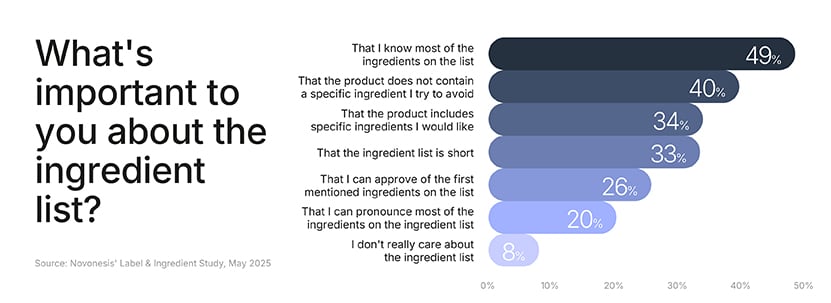Taste is key to consumer choice, but simplifying ingredients lists without damaging flavour is a challenge.
Shoppers are increasingly checking labels, questioning ingredients and demanding more from the products they purchase than ever before. This growing demand for transparency and authenticity presents a unique challenge for producers: how to simplify ingredient lists and build trust without compromising on taste and the other sensory aspects that keep customers coming back.
According to a global Novonesis study of more than 6,000 consumers, 92% care about ingredient lists, making label simplification essential for brands. A striking 68% of shoppers say they sometimes, often or very often decide not to purchase a product based on the information found on packaging.
This selectiveness reflects a strong demand for clarity and honest labeling: consumers want familiar, trustworthy ingredients and products that feel authentic and beneficial. As a result, transparency has become both a competitive advantage and the foundation for lasting consumer trust.

“Taste is still the top priority, but we also need to focus on nutrition and ingredients to earn consumer trust without losing flavour,” says Finn Wulff, Head of Consumer Insights at Novonesis.
This balance is especially important in categories like yogurt, where the appeal of gut health, protein and calcium can be challenged by added sugars or artificial ingredients. But across the board, consumers are seeking simpler, more authentic foods.
For F&B manufacturers, the shifting demands create a complex set of challenges:
- Rapidly evolving expectations Consumer preferences are dynamic. The definition of ‘healthy’ encompasses many things: from reduced sugar or fat to functional ingredients like protein, fiber and probiotics – which 50% of yogurt consumers want.
- Balancing simplicity and sensory Removing additives impacts taste, texture and shelf life. The challenge is to simplify labels without compromising the sensory experience. For bread, for instance, 64% of consumers find ingredients important, preferring short, simple lists.
- Affordability in a tough economy While consumers value quality, economic realities persist. Producers must innovate to enhance products and manage costs, keeping offerings accessible and competitive.
According to Wulff, another aspect to consider is that consumers are leading increasingly busy lives, and convenience is therefore going to shape how they consider quality.
Furthermore, with younger generations moving into the kitchen, creating products that align with this generation’s ethical and health values is going to be pivotal. All this adds more complexity to the many purposes brands have to serve.
Biological innovation as a path forward
Meeting just one of these consumer challenges is difficult enough; addressing all of them simultaneously requires a new way of thinking. Relying on methods like chemical stabilisers or artificial flavour enhancers may not resonate with consumers – and it may also present difficulties in solving multiple challenges at once.
So, how can manufacturers bridge the gap between consumer demands and production realities? The answer could be found in nature itself…
For thousands of years, biology has shaped the foods and beverages we still consume today. Enzymes, cultures and other microorganisms continue to offer a powerful way to meet these modern challenges authentically – today, we call them biosolutions.
“Our research shows that consumers embrace biosolutions and will any time choose these more natural solutions over chemical ones,” Wulff explains, highlighting the alignment between these innovations and consumer preferences.
Biosolutions are nature-based tools that have been part of food traditions for centuries – from the yeast that leavens bread to the cultures that create yogurt and cheese. Modern bioscience has unlocked their potential to solve today’s most pressing industry problems and help producers innovate even ancient recipes to meet new consumer demands.
Take juice, for instance. Consumers are increasingly concerned about high sugar content and the use of artificial additives in beverages. Shoppers are looking for transparent labels and claims like ‘100% juice’ and ‘no added sugar’, expecting products that are as close to fresh fruit as possible.
Biosolutions can help producers innovate to deliver on these expectations, enabling juice producers to reduce sugar naturally and eliminate the need for artificial additives without sacrificing taste, quality or simplicity.
By working with biology rather than against it, producers can create foods that are not only healthier and more transparent but also delicious, affordable and more consumer-friendly.
How to grow in a transforming market
The demand for transparency, health and authenticity is no longer a niche concern but a mainstream expectation that is reshaping the competitive environment. The brands that thrive will be those that view these demands not as obstacles but as a roadmap for innovation.
Success demands a commitment to understanding the deep-seated motivations of consumers and a willingness to explore new solutions that align with their values.
By embracing innovations that nature has provided, F&B producers can build greater trust, deliver superior products and secure a strong, strategic advantage in the market of tomorrow.
References


